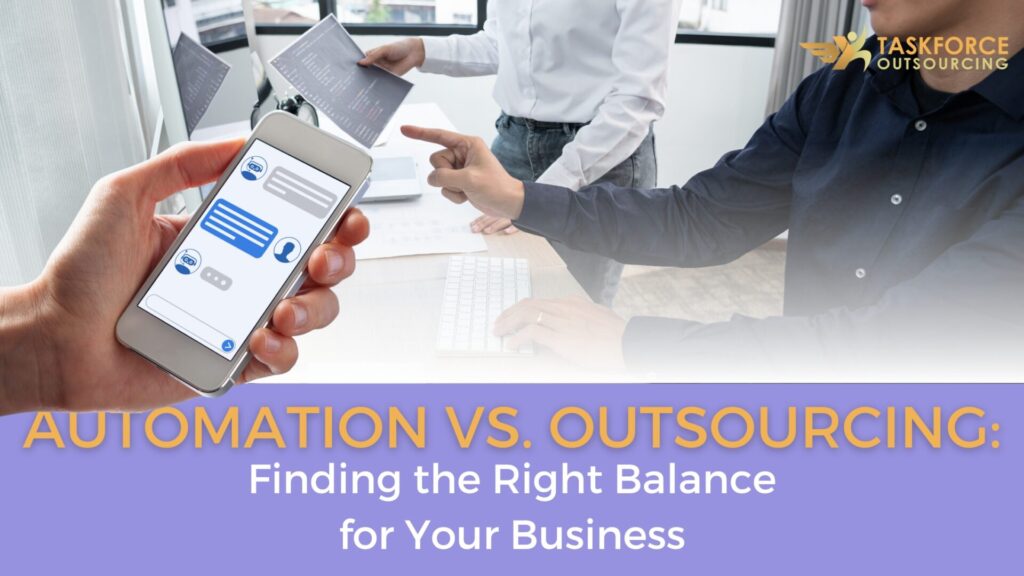Outsourcing and automation have emerged as powerful strategies to optimise processes, reduce costs, and unlock new opportunities. However, finding the right balance between outsourcing and automation is a key challenge that business leaders face. In this article, we explore the dynamic between outsourcing and automation, delving into the advantages and challenges of each approach, and highlight the importance of striking the perfect balance to drive growth and success for your business.
Contents
- 1 Introduction
- 2 Understanding Outsourcing and Automation
- 3 The Pros and Cons of Outsourcing
- 4 The Pros and Cons of Automation
- 5 Finding the Right Balance: Integrating Outsourcing and Automation
- 6 Case Study: Successful Approach to Balancing Outsourcing and Automation
- 7 Key Considerations for Implementing Outsourcing and Automation Strategies
- 8 Overcoming Challenges in Integrating Outsourcing and Automation
- 9 Conclusion
Introduction
Businesses strive to enhance their efficiency, cut costs, and maintain a competitive edge. Outsourcing and automation are two prominent strategies that offer unique benefits for companies. In order to maximise the benefits of both outsourcing and automation, it is essential to strike the right balance between the two approaches. This article will emphasise the significance of finding their combined potential and achieve optimal results for businesses.
Understanding Outsourcing and Automation
What is Outsourcing?
Outsourcing involves delegating specific tasks, functions, or processes to external service providers. Companies choose outsourcing to tap into specialised expertise, gain access to new markets, or enhance operational efficiency. Outsourcing allows businesses to focus on core competencies while leveraging external resources for non-core activities.
What is Automation?
Automation, on the other hand, refers to the use of technology and software to perform repetitive tasks or processes without human intervention. Automation streamlines workflows, reduces errors, and speeds up operations. It is often applied to tasks that are rule-based and do not require complex decision-making.
The Pros and Cons of Outsourcing

Advantages of Outsourcing
Cost Savings
Outsourcing can lead to significant cost savings, especially when labour costs are lower in the outsourcing destination. By leveraging the capabilities of specialised service providers, businesses can often reduce their overall expenditure while maintaining or even improving the quality of the outsourced activities.
Access to Expertise
Access to expertise through outsourcing is a game-changer for businesses seeking to gain a competitive advantage. By collaborating with external service providers, companies can improve quality and efficiency.
Flexibility
Being able to quickly adapt to changing circumstances is essential for gaining a competitive edge. Whether it be market fluctuations, customer demands, or unforeseen challenges. It involves being agile and proactive rather than reactive.
Disadvantages of Outsourcing
Loss of Control
When tasks are handed over to external parties, some businesses may perceive a loss of control over the processes. This concern arises from the belief that entrusting vital operations to third parties may lead to a lack of oversight, compromised quality, or deviations from established standards.
Communication Challenges
Differences in language, culture, and time zones can create communication barriers. Language barriers arise when individuals do not have a common language, which can result in misinterpretations and misunderstandings, leading to communication breakdowns. Cultural differences, on the other hand, encompass variations in norms, values, beliefs, and behaviours among different cultures, influencing communication styles and preferences. In global organisations, teams often operate in diverse time zones, making real-time communication challenging and causing delays in responses.
Dependency Risks
Reliance on external partners can also expose businesses to dependency risks. It may lead to potential negative consequences that arise when a company becomes heavily reliant on one or a few outsourcing partners for critical functions or services. This overreliance creates vulnerability if the vendor encounters difficulties or fails to meet expectations.
The Pros and Cons of Automation
Advantages of Automation
Increased Productivity
Automation aims to streamline processes and reduce the need for manual labour. By delegating such tasks to automated systems, businesses can free up human resources to focus on more complex and creative responsibilities.
Consistency and Accuracy
Accurate automated processes produce outcomes that closely align with the desired or expected results, minimising errors and discrepancies.
24/7 Operations
Automated systems allow businesses to operate outside regular business hours, providing customers with instant access to information and support. This continuous operation ensures that customers can access products, services, or support at any time.
Disadvantages of Automation
High Initial Investment
Businesses face high initial investment required to set up automated systems when considering automation implementation. Before implementing automation, conducting a comprehensive cost-benefit analysis is crucial.
Limited Adaptability
While automation is incredibly efficient for tasks with clear rules and processes, it struggles with tasks that require adaptability and flexibility. Human decision-making can be influenced by context, emotions, and experience, allowing us to navigate unpredictable situations effectively. Complex decision-making, such as strategic planning, problem-solving, and creative thinking, relies on human cognitive abilities and intuition. Automation may not possess the same level of intuition and creativity as humans.
Job Displacement Concerns
As technology advances and machines take on tasks once performed by humans, some roles are at risk of being replaced, leading to potential ramifications for employee morale and job security. While automation brings numerous advantages, such as increased productivity and reduced errors, it also raises concerns about the impact on the workforce.
Finding the Right Balance: Integrating Outsourcing and Automation
Both outsourcing and automation offer valuable advantages, but they are not mutually exclusive. The key lies in finding the right balance between the two approaches. Companies can leverage automation for repetitive, rule-based tasks and use outsourcing for activities that require human expertise or face fluctuating demand.
By combining outsourcing and automation strategically, businesses can optimise efficiency, reduce costs, and maintain control over critical processes while leveraging external resources effectively.
Case Study: Successful Approach to Balancing Outsourcing and Automation
A company that has successfully implemented both outsourcing and automation is Fox Cosmetics. They provide a diverse range of brow products along with tutorials and training services. Fox Cosmetics’ CEO effectively redirected her attention to other tasks and responsibilities by maximising the potential of a virtual assistant. The company’s virtual assistant assumes the role of managing social media platforms and websites, as well as engaging in communication with students.
You can also access a chatbot upon visiting their website. From being able to choose from the frequently asked questions and getting an immediate response, to sending your own inquiry and waiting for someone to assist you, the chatbot is an excellent approach to engaging potential clients and understanding their interests.

Check out our article titled Why Virtual Assistant Solutions are the Future of Business Operations: Increase Your Productivity and Grow Your Business and uncover how virtual assistants can be instrumental in supporting your business endeavours and enhancing overall productivity.
Key Considerations for Implementing Outsourcing and Automation Strategies
Identifying Suitable Tasks for Outsourcing and Automation
Identifying the most suitable tasks for outsourcing and automation is critical for achieving optimal results and maintaining a competitive edge. Strategically identifying tasks for these approaches can lead to enhanced efficiency, cost savings, and improved quality of services.
Evaluating Costs and Return on Investment (ROI)
Evaluating costs and ROI is a fundamental step in the process of deciding on outsourcing and automation strategies. By performing a thorough cost-benefit analysis and considering the long-term implications, businesses can make well-informed choices that align with their objectives.
Ensuring Data Security and Privacy
By implementing robust security measures to protect sensitive data and ensure compliance with data protection regulations, businesses can build trust with their customers, enhance their reputation, and mitigate potential risks associated with data breaches.
Streamlining Workflows and Processes
As businesses embrace automation and outsourcing to optimise their processes, streamlining workflows becomes a crucial aspect of ensuring seamless integration between these two strategies. Streamlined workflows enable the smooth coordination and collaboration of automated and outsourced tasks, leading to enhanced efficiency, reduced errors, and improved overall productivity.
Overcoming Challenges in Integrating Outsourcing and Automation
Integrating outsourcing and automation may pose challenges in terms of communication, coordination, and change management. To overcome these challenges, companies must foster a collaborative environment, provide proper training, and establish clear communication channels between all stakeholders.
Conclusion
Outsourcing and automation are powerful strategies that can transform businesses. The key to success lies in finding the right balance between the two approaches. By strategically integrating outsourcing and automation, companies can unlock their combined potential and achieve increased efficiency, cost savings, and sustainable growth.
Frequently Asked Questions (FAQs)
A: While automation can handle many repetitive tasks, it may not completely replace the need for human expertise in certain roles that require creativity, critical thinking, and complex decision-making.
A:Yes, outsourcing can benefit small businesses by allowing them to access specialised skills and resources without the need for significant investments.
A: Businesses can ensure data security by conducting thorough background checks on outsourcing partners, signing confidentiality agreements, and implementing secure data transfer protocols.
A: Automation can lead to job displacement in certain roles. However, it can also create new opportunities and allow employees to focus on higher-value tasks.
A: Companies should conduct a comprehensive analysis of their processes, considering factors like complexity, cost, scalability, and strategic importance to determine the best approach for each task.
Outsourcing and automation are two powerful approaches that have revolutionised how businesses function. The key to unlocking their full potential lies in finding the perfect balance between the two. Both approaches offer unique advantages, and their integration can lead to remarkable outcomes.


